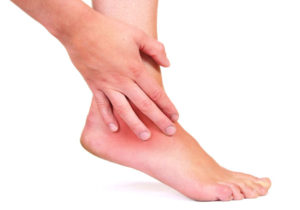Osteochondral lesions of the talus are injuries to the cartilage in the bone inside the ankle joint. This is often referred to as a chip inside your ankle joint. This commonly occurs after an ankle sprain where the two bones hit against each other, causing a piece of cartilage and bone to chip off inside the ankle. Symptoms include catching, swelling and pain in the ankle following a sprain.
The diagnosis of osteochondral lesions starts with a plain x-ray but more often than not we obtain an MRI to stage the lesion. If the lesion is not displaced and the patient is young, often they will heal in a cast. If the lesion is displaced or the lesion is cracked, most often patients undergo arthroscopic treatment. The arthroscopic treatment of osteochondral lesions of the talus depends on whether or not the cartilage is intact inside the ankle joint. If the cartilage is not intact and it is a loose fragment in the ankle, we use the arthroscope to remove the loose fragment, drill the base of the lesions (microfracture technique) and then fill in that base with stem cells that are taken from your pelvis via a small needle. This allows that lesion to fill in with fibrous tissue which functions like normal cartilage.
If the cartilage is intact and there is an area of bone injury underneath the cartilage, we often will attempt to drill the lesion from below the ankle joint and try to promote healing. We will also use stem cells during this procedure as well. Finally, for those patients who have failed arthroscopic treatment, a mosaicplasty procedure is performed where we take a part of cartilage and bone from the knee and transplant it to the ankle. The problem with this procedure is that we often have to break the ankle bone to gain access to the lesion and put the plug in exactly the right place. This is usually reserved for patients who have failed arthroscopic treatment.
There are some new exciting developments in osteochondral lesions of the talus in terms of being able to replace the cartilage damage with cartilage either from cadavers or from synthetic scaffolds. The type of surgery that is required for your osteochondral lesion depends on its size, the age of the patient, the location of the osteochondral lesion, and its characteristics on MRI. Dr. Gupta will often perform a procedure for these called Biocartilage, which is a scaffold of cadaver cartilage that contains key components of native cartilage and combines it with stem cells. This allows growth of cartilage that is much more similar to native cartilage than the fibrous cartilage seen with microfracture.


